Erie, Pennsylvania – Saturday, June 14th, 2008
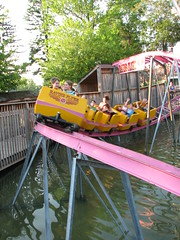 Waldameer thankfully doesn’t open until 1:00 in the afternoon so making the drive from eastern to northwestern Pennsylvania was fairly easy, getting into the park just a half hour after opening. Good thing this park is also open gate with a ticket option, since my dad was pretty well worn out and decided to just hang out for the day, with maybe one ride on the Ravine Flyer II sometime later. As long as he’s fine with that, I’m fine with that, since I was planning on meeting up with some friends from CoasterSims.com anyway and we’re now an even four instead of five.
Waldameer thankfully doesn’t open until 1:00 in the afternoon so making the drive from eastern to northwestern Pennsylvania was fairly easy, getting into the park just a half hour after opening. Good thing this park is also open gate with a ticket option, since my dad was pretty well worn out and decided to just hang out for the day, with maybe one ride on the Ravine Flyer II sometime later. As long as he’s fine with that, I’m fine with that, since I was planning on meeting up with some friends from CoasterSims.com anyway and we’re now an even four instead of five.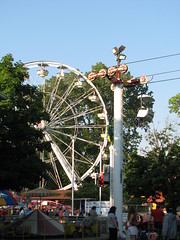 However, two got a late start from Toledo since they were watching the weather to make sure it’d be a good day for riding (there were showers all morning, the entire park was quite wet with overcast skies and puddles everywhere when I first arrived; not only perfect conditions for slick tracks on the wooden coasters, but this was the first day on the entire trip with temperatures well below the 80 degree mark), and the other was coming from Toronto, where his parents offered to drive as they wanted to do some stateside shopping in Erie with the lower tax rates, and presumably that slows things down when you’re trying to get out the door for a full day of coaster riding. So I had the first hour or so alone. After getting a feel for the park layout and exploring the gift shop, I decided, “to hell with those losers, I’m going ahead to do Ravine Flyer II by myself”.
However, two got a late start from Toledo since they were watching the weather to make sure it’d be a good day for riding (there were showers all morning, the entire park was quite wet with overcast skies and puddles everywhere when I first arrived; not only perfect conditions for slick tracks on the wooden coasters, but this was the first day on the entire trip with temperatures well below the 80 degree mark), and the other was coming from Toronto, where his parents offered to drive as they wanted to do some stateside shopping in Erie with the lower tax rates, and presumably that slows things down when you’re trying to get out the door for a full day of coaster riding. So I had the first hour or so alone. After getting a feel for the park layout and exploring the gift shop, I decided, “to hell with those losers, I’m going ahead to do Ravine Flyer II by myself”.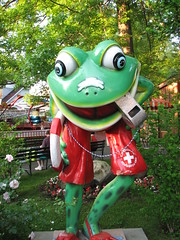
They were assigning seats but the attendant let me wait for front row for my first ride, pairing another gentleman with me. Lines for Ravine Flyer II were fairly short all day, with waits ranging from two trains to occasional walk-ons for non-preferential seats early in the afternoon, eventually increasing to about 10-15 minute waits later that evening, before tapering off again in the last hour or so. While waiting for my first train I noticed park owner Paul Nelson on the unload platform, quietly watching operations. I would have gone over to thank him for the effort he put in over the years to get the Ravine Flyer built, but he was gone by the time I was back to the station.
Disembarking from my first ride on Ravine Flyer in the front seat, was it everything I was hoping it to be? Well, first I should clarify what I was hoping it to be. It’s a Gravity Group terrain coaster, so the enthusiast boards online were building it up as nearly a mythological creature, created by the gods as a gift from heaven. “It’s going to be this decade’s The Raven”, I recall proclaiming at one point when groundbreaking was underway and early renderings were posted showing off the use of terrain at multiple points along the ride,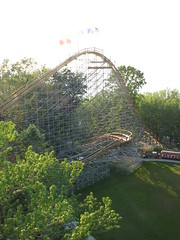 the stunning arch bridgeway and the promise of six or seven tunnels. Made sense, not just because both also share extremely similar sounding names. I was confident it would make my top ten at the end of the trip, and secretly hoping I could place it as high as my number five spot without any shame that I was doing so just because it’s a new Gravity Group coaster where all of this year’s buzz was focused.
the stunning arch bridgeway and the promise of six or seven tunnels. Made sense, not just because both also share extremely similar sounding names. I was confident it would make my top ten at the end of the trip, and secretly hoping I could place it as high as my number five spot without any shame that I was doing so just because it’s a new Gravity Group coaster where all of this year’s buzz was focused.
After my first ride, I’m thinking, “I’m not sure if any of those parts ever exceeded anything I’d find on an average CCI coaster. Come to think of it, besides the ninety-degree bankings, this ride does feel like it could be brothers with the multitude of mid-sized CCI creations, they share the same roots after all. Am I giving it special treatment just because it’s built under the Gravity Group banner, and possibly features some more advanced banking techniques and smoother, more sophisticated tracking (which could even be perceived as a bad thing as it takes off the edge and  intensity that makes some of the old CCI rides great)?”
intensity that makes some of the old CCI rides great)?”
But wait, the use of terrain was quite impressive and did keep each moment of the ride feeling fresh and unique from the previous, even if nothing in particular really knocked my socks off. As I recall I had a similar impression of The Raven on my first ride, it just required many more re-rides to fully appreciate its uniqueness and progression that set it apart from other mid-sized coasters. That’s it, Ravine Flyer II is an acquired taste, one that I’ll come to love even more than a ride that’s big and showy on the first time around but later reveals itself to be rather shallow and gimmicky as I begin to internalize it’s movements on subsequent trips.”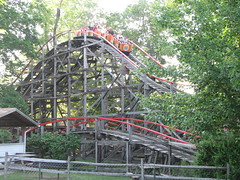
After a second ride on Ravine Flyer II in the back car I got a call from my Toledo friend who was just about inside the park. Some more Ravine Flyer II rides (have I come to truly love it yet? Not yet, if anything I’m beginning to notice that the 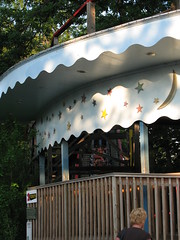 pacing in the final hills is really slow) we then decided to try out Waldameer’s other wooden coaster, the classic Comet. This one is just a basic model Herb Schmeck double out-and-back junior woody built in the 1950’s to accommodate the demand from the baby boomers, later to be copied by his successor John Allen at the Paramount Parks in the 1970’s and later still by CCI with the Zach’s Zoomer, my first true roller coaster ride. The main difference with this one is the age, featuring a classic curved station with 50’s retro boarding platform design and PTC trains that pre-date seat dividers, plus a dense canopy of mature trees that have grown in and around the ride area. Unfortunately the ride itself isn’t anything interesting, with next to no airtime or other sensations found along the basic layout, fine for families I suppose, but even in that case, I’d still recommend riding the Comet before visiting Idlewild’s Rollo Coaster so as not to disappoint too much.
pacing in the final hills is really slow) we then decided to try out Waldameer’s other wooden coaster, the classic Comet. This one is just a basic model Herb Schmeck double out-and-back junior woody built in the 1950’s to accommodate the demand from the baby boomers, later to be copied by his successor John Allen at the Paramount Parks in the 1970’s and later still by CCI with the Zach’s Zoomer, my first true roller coaster ride. The main difference with this one is the age, featuring a classic curved station with 50’s retro boarding platform design and PTC trains that pre-date seat dividers, plus a dense canopy of mature trees that have grown in and around the ride area. Unfortunately the ride itself isn’t anything interesting, with next to no airtime or other sensations found along the basic layout, fine for families I suppose, but even in that case, I’d still recommend riding the Comet before visiting Idlewild’s Rollo Coaster so as not to disappoint too much.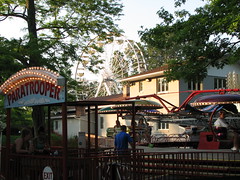
We also checked out some of the other flat rides in the park, such as their Wipeout. It’s curious that in manufacturing a ride where the only purpose is to press you against the outside seat edge for as long as possible, no one thought that they should actually make a seat edge designed for such, since that’s where would-be riders are spending most of their time. I’ll admit the look of Waldameer disappointed me slightly. From photos it appeared to be a nicely landscaped, expansive park secluded in the woods just next to the Lake Erie coastline, and even looking at my own photos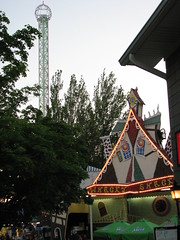 from the park I’d still get that impression. However, actually walking around it in I was aware that the treeline was very shallow with gas stations and other commercial strips not far away in any direction, and the park itself felt much smaller with more asphalt pathways between rides than landscaping, and an overall lack of unique identity that is present at many of Pennsylvania’s other small parks. Perhaps the cooler, wetter weather impacted my overall impression of the place somewhat, but I couldn’t help but shake the feeling that the park started as a carnival sometime in the 70’s or 80’s, and only in the past decade started to build up a nicer collection of high-profile rides and landscape some of the area. One aspect of Waldameer I did like was the unique collection of statues they had around the park, and the obvious attention to detail along some rides like the Ravine Flyer 3 and the Convoy Truck Ride. Still, these features mostly seem like they could belong to Any Small Park,
from the park I’d still get that impression. However, actually walking around it in I was aware that the treeline was very shallow with gas stations and other commercial strips not far away in any direction, and the park itself felt much smaller with more asphalt pathways between rides than landscaping, and an overall lack of unique identity that is present at many of Pennsylvania’s other small parks. Perhaps the cooler, wetter weather impacted my overall impression of the place somewhat, but I couldn’t help but shake the feeling that the park started as a carnival sometime in the 70’s or 80’s, and only in the past decade started to build up a nicer collection of high-profile rides and landscape some of the area. One aspect of Waldameer I did like was the unique collection of statues they had around the park, and the obvious attention to detail along some rides like the Ravine Flyer 3 and the Convoy Truck Ride. Still, these features mostly seem like they could belong to Any Small Park,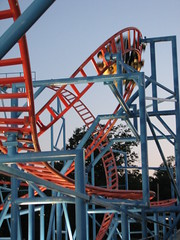 Anywhere, and not necessarily Waldameer Park, Erie Pennsylvania.
Anywhere, and not necessarily Waldameer Park, Erie Pennsylvania.
Eventually our Toronto friend finally made it into the park around 4:00, somewhat confused about how to get to the entrance (the ticket booths are actually located somewhere in the middle of the park. Curiously enough, they’re still designed like an entry ticket gate that you have to walk through, rather than just a booth like Knoebel’s has set-up, despite the fact that you can walk around them from all sides.) Since we were now four, it seemed like a good time to give the Steel Dragon a spin. I’ll just say it straight out, this was the best spinning coaster I’ve been on after Kennywood’s Exterminator. Despite the compact, portable footprint it eschews all expectations for a standard spinning mouse progression with some unique elements (including an extended trick-track section of track and the park’s other 90 degree bank turn), and a fast pacing that starts right off with the large curving drop right off the lift-hill. The degree of spinning was a bit hit or miss on our rides. First time around that afternoon we got a decent amount of spinning,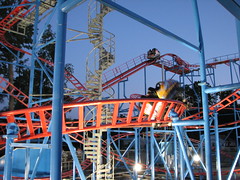 but the next time or two there was a notable lack of spin. For our final ride later that evening, we asked if it would be possible to ride as two pairs in two cars rather than a foursome in one, much to the chagrin of those waiting immediately behind us. I would not begrudge anyone else from splitting up a party of four into two cars since the difference having the weight completely off-balance made was immense. As soon as the lock was flipped off our off-balanced car started spinning like an inner-city kid’s wheel rims, and would not stop until coming into the station. Apart from the incongruous name and Superman color scheme this was a quite good investment for the park to help bridge the gap between the Comet and Ravine Flyer II.
but the next time or two there was a notable lack of spin. For our final ride later that evening, we asked if it would be possible to ride as two pairs in two cars rather than a foursome in one, much to the chagrin of those waiting immediately behind us. I would not begrudge anyone else from splitting up a party of four into two cars since the difference having the weight completely off-balance made was immense. As soon as the lock was flipped off our off-balanced car started spinning like an inner-city kid’s wheel rims, and would not stop until coming into the station. Apart from the incongruous name and Superman color scheme this was a quite good investment for the park to help bridge the gap between the Comet and Ravine Flyer II.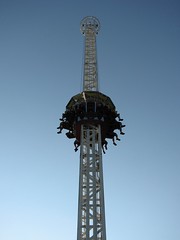
Other rides tried out included the X-Scream drop tower (very effective, just make sure not to get out too quickly to prevent a painful tingling in your foot), Bumper Cars (lamest ever, with those 80’s ‘sleek’ fiberglass Fischer-Price cars), Raging River (double-lift Hopkins log flume akin to Knoebel’s Flume with a potential to get very wet), Pirate’s Cove (a walk-through dark ride, basically a queue that takes you past gags such as a head stuck in the toilet) and the Whacky Shack (a ride-through dark ride, as I recall some of the set-pieces were also used in Knoebel’s Haunted Mansion, notably a shrinking prop door effect). A ride on their Ferris wheel was also mandatory in order to get some proper shots of the park and of Ravine Flyer II’s far leg. And after many more rides on the Ravine Flyer II throughout the day, had I grown to love it yet, like I predicted I might after that first run?
A proper ride analysis should answer that question.
What initially drew me to the Ravine Flyer II during the construction was the apparent progression and use of terrain on the ride. Even rides like the Raven, Beast and Voyage only use terrain to gain speed over longer stretches of track at ground level, or to extend a drop a bit further than would normally be expected thanks to a slight downward grade in the land. Ravine Flyer uses terrain much more dramatically, with many of the hills actually following the steep curvature of the land to get most of the drop height, akin to Kennywood’s Thunderbolt and Phantom’s Revenge. From the overhead rendering, it was clear that this would also benefit the overall ride progression, where the first half takes place mostly on level land on the lower level the terrain, while the second has several instances of jumping between upper and lower levels, definitely an increased dramatic effect to help distinguish the two halves. It should also be noted however that the absolute lowest point of the ride is found on the stretch after the return cross over the bridge, allowing the first half to maintain its speed, if not increase it. A moment’s pause would also be provided on the turnaround before diving into the second largest drop of the ride (80+ ft.), something I hoped would have a similar effect on the overall progression as the Raven’s middle 61’ drop.
during the construction was the apparent progression and use of terrain on the ride. Even rides like the Raven, Beast and Voyage only use terrain to gain speed over longer stretches of track at ground level, or to extend a drop a bit further than would normally be expected thanks to a slight downward grade in the land. Ravine Flyer uses terrain much more dramatically, with many of the hills actually following the steep curvature of the land to get most of the drop height, akin to Kennywood’s Thunderbolt and Phantom’s Revenge. From the overhead rendering, it was clear that this would also benefit the overall ride progression, where the first half takes place mostly on level land on the lower level the terrain, while the second has several instances of jumping between upper and lower levels, definitely an increased dramatic effect to help distinguish the two halves. It should also be noted however that the absolute lowest point of the ride is found on the stretch after the return cross over the bridge, allowing the first half to maintain its speed, if not increase it. A moment’s pause would also be provided on the turnaround before diving into the second largest drop of the ride (80+ ft.), something I hoped would have a similar effect on the overall progression as the Raven’s middle 61’ drop.
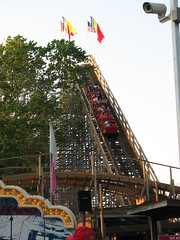 However, what initially turned me off Ravine Flyer II during my first few rides was a sense of relative tameness and control, especially during the second half. Like I mentioned before, the scale is about on the same levels as many of CCI’s old creations, and while Ravine Flyer II might boast some new tricks thanks to improved engineering by the Gravity Group since CCI’s time, there was also something a bit off-putting about the improved banking and tracking techniques. CCI’s turns were chronically underbanked, and at constant pitches, producing some pretty raw, out-of-control lateral forces. The banking on Ravine Flyer II (and GG’s other rides) is clearly far more intricate, constantly shifting throughout the turn to better adjust to changing conditions in the lateral forces, which while still present, do feel much more controlled.
However, what initially turned me off Ravine Flyer II during my first few rides was a sense of relative tameness and control, especially during the second half. Like I mentioned before, the scale is about on the same levels as many of CCI’s old creations, and while Ravine Flyer II might boast some new tricks thanks to improved engineering by the Gravity Group since CCI’s time, there was also something a bit off-putting about the improved banking and tracking techniques. CCI’s turns were chronically underbanked, and at constant pitches, producing some pretty raw, out-of-control lateral forces. The banking on Ravine Flyer II (and GG’s other rides) is clearly far more intricate, constantly shifting throughout the turn to better adjust to changing conditions in the lateral forces, which while still present, do feel much more controlled.
That’s getting ahead of things. Starting from the beginning, that first drop. Overlooking Lake Erie, no less. I can think of at least one other ride that starts with that, and my opinion of that one is quite high as well. 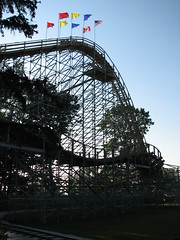 How’s the airtime? Not much in the front, and while there’s a bit of a kick in the back it’s more reserved than I was expecting, not suddenly yanking the way some coasters do right on the transition from flat track to curved drop. The tunnel at the base of the drop makes the whole thing very reminiscent of the Legend, although I’d give that one an edge in terms of brute force (both airtime at the crest and laterals at the bottom). However, Ravine Flyer immediately outshine the Legend by following this up with the relatively low and lean bridge hill, which maintains an incredibly strong pace while providing sustained air. But again, the air just didn’t feel quite as magical on this ride like it does on some others. On one trip over the bridge I had a metaphorical snap of the fingers as I realized what it was – the individual ratcheting restraints. After spending the entire day prior to this one with a good six inches between my rear and my seat on the Phoenix, my bum just wasn’t used to being kept in place by the snug-fitting bars. Maybe I was just spoiled, but I was feeling oddly constrained being in my first modern PTC cars on the entire trip.
How’s the airtime? Not much in the front, and while there’s a bit of a kick in the back it’s more reserved than I was expecting, not suddenly yanking the way some coasters do right on the transition from flat track to curved drop. The tunnel at the base of the drop makes the whole thing very reminiscent of the Legend, although I’d give that one an edge in terms of brute force (both airtime at the crest and laterals at the bottom). However, Ravine Flyer immediately outshine the Legend by following this up with the relatively low and lean bridge hill, which maintains an incredibly strong pace while providing sustained air. But again, the air just didn’t feel quite as magical on this ride like it does on some others. On one trip over the bridge I had a metaphorical snap of the fingers as I realized what it was – the individual ratcheting restraints. After spending the entire day prior to this one with a good six inches between my rear and my seat on the Phoenix, my bum just wasn’t used to being kept in place by the snug-fitting bars. Maybe I was just spoiled, but I was feeling oddly constrained being in my first modern PTC cars on the entire trip.
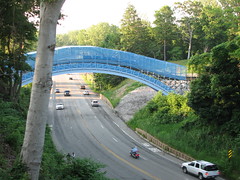 After the bridge fly-over it was a very intense, quickly paced back-and-forth as it entered the turnaround. A lot of reviews I’ve read have referred to this ride as being very out of control, and I’ve always assumed that this section of the ride is what the writer specifically had in mind. It’s not just laterals, but incredibly tight pacing as each movement from the right to the left to the right again takes place within a fraction of a second. It’s these first three elements – the drop, bridge hill and back-and-forth- where I think the Ravine Flyer II shines most brightly. Everything is there, a long drop, fast speeds, tunnels, sustained airtime, and culminating in this final, quite devious maneuver. It’s therefore a shame that the ride has to follow it up with one of its most disappointing moments.
After the bridge fly-over it was a very intense, quickly paced back-and-forth as it entered the turnaround. A lot of reviews I’ve read have referred to this ride as being very out of control, and I’ve always assumed that this section of the ride is what the writer specifically had in mind. It’s not just laterals, but incredibly tight pacing as each movement from the right to the left to the right again takes place within a fraction of a second. It’s these first three elements – the drop, bridge hill and back-and-forth- where I think the Ravine Flyer II shines most brightly. Everything is there, a long drop, fast speeds, tunnels, sustained airtime, and culminating in this final, quite devious maneuver. It’s therefore a shame that the ride has to follow it up with one of its most disappointing moments.
 The extended turnaround that the back-and-forth exits into what is in my opinion an overly-banked turnaround that only looses speed as it makes its way around the incline. This would be fine if it could set up the next drop. The only problem is, somehow this second big drop managed to fall flat. Not only was there hardly any air from any seat but it also somehow managed to not feel very long. The turns that border either end of it (the long right turn that leads into the small rise before the drop,
The extended turnaround that the back-and-forth exits into what is in my opinion an overly-banked turnaround that only looses speed as it makes its way around the incline. This would be fine if it could set up the next drop. The only problem is, somehow this second big drop managed to fall flat. Not only was there hardly any air from any seat but it also somehow managed to not feel very long. The turns that border either end of it (the long right turn that leads into the small rise before the drop,  and also the slight left-hand tip before crossing the bridge the second time) have transitions that lead much too far into either end of this element, deadening its overall impact and making it feel smaller than it really is. Perhaps it’s also that this happens too early into the ride. The first three elements I praised last hardly seconds before it reaches the turnaround, so it does not work so well as a mid-point but rather a sudden let-up in pace.
and also the slight left-hand tip before crossing the bridge the second time) have transitions that lead much too far into either end of this element, deadening its overall impact and making it feel smaller than it really is. Perhaps it’s also that this happens too early into the ride. The first three elements I praised last hardly seconds before it reaches the turnaround, so it does not work so well as a mid-point but rather a sudden let-up in pace.
Oh well, that’s something that can easily break in with time. The second bridge cross is basically the same as the first, only with reduced speed not being right off the initial drop. One nice little trick on this second cross-over is that on the exit it dives down much farther than anticipated into the unseen tunnel. Watch the POV video of it, and when you’re first cresting this hill you see a clear and open exit from the blue mesh netting that surrounds the bridge, just like on the first time around. This return hill however ends up curving down much steeper and very suddenly skips below that clear opening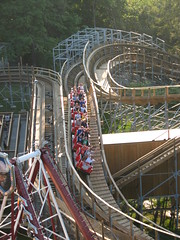 from the netting into an unseen, darkened tunnel a full level below it. This is probably my second favorite part of the ride, this low return section through the two tunnels with two airtime hills. As I recall I found the air on this stretch of the ride to be the most powerful, with the two tunnels heighten the sense of speed, coupled with the aural effect of the echoes of thundering air and screams inside them, although the second tunnel was frustratingly short and for some odd reason not fully covered on the left side, somewhat dimming the effect from what was experienced in the first tunnel.
from the netting into an unseen, darkened tunnel a full level below it. This is probably my second favorite part of the ride, this low return section through the two tunnels with two airtime hills. As I recall I found the air on this stretch of the ride to be the most powerful, with the two tunnels heighten the sense of speed, coupled with the aural effect of the echoes of thundering air and screams inside them, although the second tunnel was frustratingly short and for some odd reason not fully covered on the left side, somewhat dimming the effect from what was experienced in the first tunnel.
It’s after this second tunnel that I would probably classify as the midpoint of the ride. It’s here that the elevation changes start to have a big effect on the ride experience as it switches to a more twisted, curve-based layout as well. However, the more and more I rode the Ravine Flyer, the more it sunk in… “This doesn’t work”. The problem is simply that the change in elevation at this point in the ride serves only to very abruptly loose speed, and this speed is never regained. I’m not sure why I didn’t see this when I was first looking at the renderings, perhaps I figured that the size of elements would be reduced so the relative speed would remain the same at this point in the ride while we were climbing up the hills, but it wasn’t so. The first half of the ride is basically what you’d experience from any wooden coaster built on level ground with a 120 ft. tall lift hill, the only difference being that the lift was closer to 80 ft. tall. The resulting effect being that the first half of the ride belongs to a 120 ft. tall coaster, the second half belongs to an 80 ft. tall coaster (that’s not even factoring in the friction loss from the first half), effectively devastating any progression to be found in the coaster, at least through the use of terrain. The air hill and curves on the upper level are all sized about the same as on the first half, so this section of the ride just feels weak, more like a family thrill wooden coaster, rather than the more ferocious beast
be reduced so the relative speed would remain the same at this point in the ride while we were climbing up the hills, but it wasn’t so. The first half of the ride is basically what you’d experience from any wooden coaster built on level ground with a 120 ft. tall lift hill, the only difference being that the lift was closer to 80 ft. tall. The resulting effect being that the first half of the ride belongs to a 120 ft. tall coaster, the second half belongs to an 80 ft. tall coaster (that’s not even factoring in the friction loss from the first half), effectively devastating any progression to be found in the coaster, at least through the use of terrain. The air hill and curves on the upper level are all sized about the same as on the first half, so this section of the ride just feels weak, more like a family thrill wooden coaster, rather than the more ferocious beast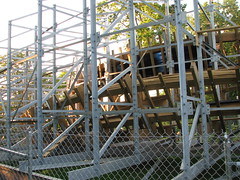 glimpse at from the first moments of the ride when at its highest speed.
glimpse at from the first moments of the ride when at its highest speed.
Before giving up hope on the second half, there is one thing that might end up saving it: the 90 degree banked turn that leads into the second dive down in the ravine. I really hoped so, and wanted it to, since not only do we get the most ‘extreme’ moment of the ride out the banking, but the extended drop into the ravine would act as quite a surprise, and the sudden re-emergence of some speed in the final moments of the ride would also redeem the sudden slowdown experienced from entering the first half. Somehow, none of these effects worked. I know this review has probably been uniquely disparaging of the ride so far, you may even be thinking of rebuttals to some of my points based on other 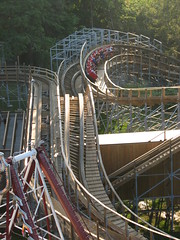 reviews you may have read (or perhaps you’ve even been on the ride yourself and have a different opinion—please post comments if so!) but I’m quite positive the overall consensus among at least people that I’ve talked to is that the 90 degree banked turn is weak. Close your eyes and you won’t even know it was there (this was most clearly realized after Hades’ opening when people didn’t even know a 90 degree bank was inside that pitch black tunnel). It’s just too perfectly designed to minimize any laterals, and the strong curvature of the turn removes any rotational forces that might have been experience. See Maverick’s first Stengel dive for an example of the polar opposite to see what I mean. Alright, it’s maybe still a bit cool to look at, and at least it has the ravine dive to back it up. Here’s the big problem. Like the dive off of the turnaround, this one lacks any air due to the long lead-out transition from the 90 degree bank. There’s hardly even any sensation of dropping farther than expected since the pitch of the drop is very muted thanks also to the long lead-out of the 90 degree bank, and the additional speed is not used for much
reviews you may have read (or perhaps you’ve even been on the ride yourself and have a different opinion—please post comments if so!) but I’m quite positive the overall consensus among at least people that I’ve talked to is that the 90 degree banked turn is weak. Close your eyes and you won’t even know it was there (this was most clearly realized after Hades’ opening when people didn’t even know a 90 degree bank was inside that pitch black tunnel). It’s just too perfectly designed to minimize any laterals, and the strong curvature of the turn removes any rotational forces that might have been experience. See Maverick’s first Stengel dive for an example of the polar opposite to see what I mean. Alright, it’s maybe still a bit cool to look at, and at least it has the ravine dive to back it up. Here’s the big problem. Like the dive off of the turnaround, this one lacks any air due to the long lead-out transition from the 90 degree bank. There’s hardly even any sensation of dropping farther than expected since the pitch of the drop is very muted thanks also to the long lead-out of the 90 degree bank, and the additional speed is not used for much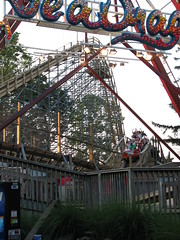 since it immediately pulls back up the ravine.
since it immediately pulls back up the ravine.
Perhaps one final chance at a strong ending? Two very tight bunny hills could be the answer, reminiscent somewhat of Thunderhead’s fast-paced, airtime laced ‘skipping’ found in its second half, and better yet, a chance to mirror the fast back-and-forth found at the beginning of the ride, two spots where this rapid-fire, tightly plotted pacing are found on this ride, but in opposite forms (airtime verses laterals). Does it work? No. The anti-rollbacks found on the hills should have been a clue that this was going to be a low-speed area, but I was still tremendously disappointed that these hills offered nothing for air, or rapid pacing, or much of anything. On the ride where I closed my eyes on the 90 degree bank turn to see if I could feel anything only to get nothing, I did the same with these final hills, and I found that I nearly could have been on a straight-away for all I knew. The only slightest sensation I recall was a slight forward push as it transitioned into the pull-up going down the hill, otherwise it was nothing. A left-hand turn into the brakes, and the ride is over.
Laying out the entire sequencing of the ride experience on paper, it seems as though it goes back and forth between relatively strong sections and relatively weak sections, which the strength or weakness of each section directly correlating to how fast it happens to be going. The out run; strong. The turnaround; weak. The return run; strong. The upper ravine level section; weak. The 90 and ravine dive; strong. The final hills; weak. Secondly, the absolute strength of each section seems to dissolve as the ride goes on, leaving the final ‘strong point’ of the 90 and last ravine dive being somewhat weaker than even the first ‘weak point’ of the far turn around. This again directly correlates to the loss of speed as the ride goes on. The end result of all this is that the Ravine Flyer II falls far, far short of the greatness achieved by other terrain coasters that are able to use their land to the advantage of their ride progression, not disadvantage (i.e. Raven, Thunderbolt, Voyage).
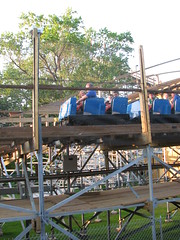 After all of these negative remarks, it may surprise you to find that the ride still managed to find its way into my #16 slot for top wooden coasters, just below the Phoenix. Is it just because I’m still clinging to the mythology surrounding the Gravity Groups rides, blindly believing that there is some innate greatness in it even though my analysis of the ride turned it to shit? Well, no, it’s because I honestly feel that this coaster bests the likes of rides like the Ozark Wildcat, Knoebels Twister or Hersheypark Wildcat. The fact of the matter is that it still does use the terrain in quite a unique way, a way that has a definite impact on the ride experience and sets it apart from its level-landed counterparts. Furthermore, where it shines (mostly on the first three elements as well as the returning bunny hops inside the two tunnels) it’s really bright. And lastly, this progression analysis really doesn’t have as big of an effect on the ride as I make it sound like. As much as I would like coasters to work on the mind in the same way as music, there’s no denying that much of what makes them work is the effects on the adrenal glands, something that’s mostly devoid of other art forms, so simply having those awesome parts at all goes a long way.
After all of these negative remarks, it may surprise you to find that the ride still managed to find its way into my #16 slot for top wooden coasters, just below the Phoenix. Is it just because I’m still clinging to the mythology surrounding the Gravity Groups rides, blindly believing that there is some innate greatness in it even though my analysis of the ride turned it to shit? Well, no, it’s because I honestly feel that this coaster bests the likes of rides like the Ozark Wildcat, Knoebels Twister or Hersheypark Wildcat. The fact of the matter is that it still does use the terrain in quite a unique way, a way that has a definite impact on the ride experience and sets it apart from its level-landed counterparts. Furthermore, where it shines (mostly on the first three elements as well as the returning bunny hops inside the two tunnels) it’s really bright. And lastly, this progression analysis really doesn’t have as big of an effect on the ride as I make it sound like. As much as I would like coasters to work on the mind in the same way as music, there’s no denying that much of what makes them work is the effects on the adrenal glands, something that’s mostly devoid of other art forms, so simply having those awesome parts at all goes a long way.
 Maybe it’s also because it has that new Gravity Group smell to it. If you don’t know what it is, it’s the smell of fresh-cut lumber on galvanized steel, aromatizing from the bright June sunlight, still juicy from the morning rain storms. For some reason I have not experienced anywhere near this strong or pleasant of a smell from other new wooden coasters, besides Hades, Voyage and Ravine Flyer II. Alright, maybe this is a stupid point in determining a coaster’s overall worth, but before dismissing it completely, consider the possibility that the ever-present aromatic effect could have some subtle psychological effect on the brain, registering and categorizing the experiences slightly differently than it would otherwise due to the added sense inputs from the nose, toying with its various processes. There, you’ve thought about it
Maybe it’s also because it has that new Gravity Group smell to it. If you don’t know what it is, it’s the smell of fresh-cut lumber on galvanized steel, aromatizing from the bright June sunlight, still juicy from the morning rain storms. For some reason I have not experienced anywhere near this strong or pleasant of a smell from other new wooden coasters, besides Hades, Voyage and Ravine Flyer II. Alright, maybe this is a stupid point in determining a coaster’s overall worth, but before dismissing it completely, consider the possibility that the ever-present aromatic effect could have some subtle psychological effect on the brain, registering and categorizing the experiences slightly differently than it would otherwise due to the added sense inputs from the nose, toying with its various processes. There, you’ve thought about it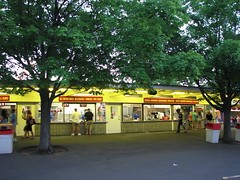 for two seconds, now you can dismiss this entire review as lunatic rantings because it made ‘smell’ a larger critical focus than ‘airtime’.
for two seconds, now you can dismiss this entire review as lunatic rantings because it made ‘smell’ a larger critical focus than ‘airtime’.
We managed just a few rides in the waning twilight, with only the final ride of the night being fully in the dark. Waldameer was another park that had very strict closing policies, with attendants at the gate of Ravine Flyer to make sure the queue was shut off before the 10:00pm closing that night so that way everyone would be filtered out of the park right on time. My dad finally decided to rejoin me for one ride on the Ravine Flyer, and was given a moment’s scare when, after buying the ticket amount for one ride, arrived at the entrance only to find that they had already shut it off. We were getting a ride on the Ravine Flyer at the time and by the time we got off they had apparently re-opened it after realizing it was shut off too soon. My Toronto friend needed to head back with his parents at that time, so it worked out well as we would still be four.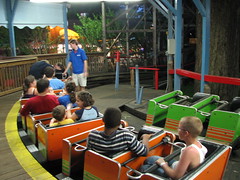 For the last ride my dad and I managed the very back row (they were not allowing any waiting for any seats by this time; between that and the strict closing time I was a bit miffed at some of Waldameer’s operational policies). That night ride was quite good, very dark. There were quite a few lights on in the background from the surrounding buildings, but nothing shining directly on the track, which made for a very disorienting ride. I wouldn’t say the ride itself was transformed in the way some coasters are by the darkness, I still had problems with how poorly it handled all the lower speed sections of track, but it was probably the best ride of the day, and my dad approved of his one ride, noting that he hopes to come back some day to fully figure out the entire layout.
For the last ride my dad and I managed the very back row (they were not allowing any waiting for any seats by this time; between that and the strict closing time I was a bit miffed at some of Waldameer’s operational policies). That night ride was quite good, very dark. There were quite a few lights on in the background from the surrounding buildings, but nothing shining directly on the track, which made for a very disorienting ride. I wouldn’t say the ride itself was transformed in the way some coasters are by the darkness, I still had problems with how poorly it handled all the lower speed sections of track, but it was probably the best ride of the day, and my dad approved of his one ride, noting that he hopes to come back some day to fully figure out the entire layout.
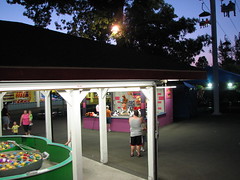 With that final ride we parted ways with my Toledo friends and found our car. We had discussed finding at hotel around Sandusky that night and then spending the next day at Cedar Point with our season passes, which we had not visited yet that year. While I was exhausted (finally), my fully rested dad offered to drive the entire way back to Michigan that night since we really didn’t need another day of coasters on top of all that we had just done, and also didn’t need to spend any more money on a hotel if we didn’t need it. I got back around 4:00 am that morning incredibly groggy and perhaps still somewhat disappointed that the closing rides of the trip on Ravine Flyer weren’t the otherworldly fantastic experience I was hoping for, but how could I possibly not be completely fulfilled from the entire ten days? I’d really like to thank my dad for accompanying me on this expedition, doing more than his fair share of the tough driving while also putting up with the obscure small parks I’d insist we’d stop at; we’ve been doing big summer coasters trips together since 2001 and I’m afraid that between the economy and simply moving on in life this may have been our last big one together, but it is without a doubt in my mind the best and certainly most ambitious we’ve ever undertook, and it shouldn’t be too hard to fit in a short weekend trip together in summers to come.
With that final ride we parted ways with my Toledo friends and found our car. We had discussed finding at hotel around Sandusky that night and then spending the next day at Cedar Point with our season passes, which we had not visited yet that year. While I was exhausted (finally), my fully rested dad offered to drive the entire way back to Michigan that night since we really didn’t need another day of coasters on top of all that we had just done, and also didn’t need to spend any more money on a hotel if we didn’t need it. I got back around 4:00 am that morning incredibly groggy and perhaps still somewhat disappointed that the closing rides of the trip on Ravine Flyer weren’t the otherworldly fantastic experience I was hoping for, but how could I possibly not be completely fulfilled from the entire ten days? I’d really like to thank my dad for accompanying me on this expedition, doing more than his fair share of the tough driving while also putting up with the obscure small parks I’d insist we’d stop at; we’ve been doing big summer coasters trips together since 2001 and I’m afraid that between the economy and simply moving on in life this may have been our last big one together, but it is without a doubt in my mind the best and certainly most ambitious we’ve ever undertook, and it shouldn’t be too hard to fit in a short weekend trip together in summers to come.
Comments